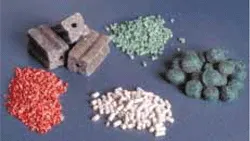Rodenticide Toxicity

A 6-month-old intact male boxer presented 2 hours after rodenticide ingestion.
History. The owner brought in a packet of what she called "D-con." The pellets are small, blue-green in color, and have a slightly waxy texture. According to the owner, the dog ingested one 0.75-oz packet of the pellets. The owner had attempted to induce emesis with hydrogen peroxide but was unsuccessful.
Examination. The 40-pound puppy is bright, alert, and responsive. Vital signs are normal. No significant abnormalities are found on physical examination.

Rodenticides vary considerably in shape, size, and color, but none of these features is helpful in identifying the active ingredient, the name of which must be obtained from the product package or pest control service invoice.
Ask Yourself...Based on the information provided by the owner and evaluation of the pellets, what type of rodenticide has the dog ingested?A. anticoagulantB. bromethalinC. cholecalciferolD. strychnineE. unknown
Correct Answer: EUnknown rodenticide
Rodenticides cannot be positively identified based upon color, texture, or formulation (e.g., pellets vs bars). Although most residential rodenticides are one of the ABCs (i.e., anticoagulant, bromethalin, cholecalciferol), in some areas strychnine may still be available for use. Whenever possible, owners should be instructed to bring in the container to help determine the type of rodenticide. Brand names alone may be of limited value-manufacturers may market several types of rodenticide under the same brand name. Rodenticides left by professional exterminators should be identified on the invoice/receipt that the exterminator left behind. When a human or animal poison control center is consulted, the most valuable information for identifying the type of rodenticide is the Environmental Protection Agency registration number, which is required for all rodenticide packages.
Mechanisms of Action. Anticoagulant rodenticides interfere with recycling of vitamin K and thus deplete vitamin K-dependent clotting factors II, VII, IX, and X. As these factors become depleted (generally between 2 and 5 days after exposure), uncontrolled bleeding develops. Measurement of PT can often detect elevated clotting times before clinical bleeding occurs. Vitamin K1 therapy can effectively counteract the effects of anticoagulant rodenticides (see Tx at a Glance).
Bromethalin is a neurotoxin that seems to be increasingly used in the United States. Bromethalin uncouples oxidative phosphorylation, causing vacuolation of the myelin sheaths of the nervous system. Interference with nerve impulse conduction results in dose-dependent neurologic dysfunction that may be sudden (convulsant syndrome-seizures and death within 36 hours of ingestion) or insidious (paralytic syndrome -ascending paresis/paralysis that may progress to CNS signs [such as behavior disorders and seizures] within 3 to 5 days of exposure). Unlike anticoagulants, bromethalin has no effective antidote, and animals showing severe CNS signs generally die despite treatment. Less-affected animals can recover, but recovery may be prolonged and/or incomplete.
Cholecalciferol rodenticides cause elevations in serum calcium and phosphorus, which lead to mineralization of soft tissues. Most commonly, renal failure develops, although mineralization within the myocardium or meninges can cause fatal arrhythmia or cerebral hemorrhage, respectively. Cholecalciferol has a long half-life; thus, hypercalcemia treatment can be protracted.
Treatment. If it is impossible to determine which rodenticide is involved, recommended management includes decontamination (emesis and/or activated charcoal); measuring PT and serum calcium and phosphorus; and monitoring for CNS signs. Symptomatic and supportive care-which may include blood transfusions, anticonvulsants, and fluid therapy-should be provided as needed.
Case Presentation Follow-up. In this case, emesis was induced but only a small amount of bait was recovered. Activated charcoal was administered. According to the package, the active ingredient was 0.01% bromethalin (the rodenticide was not a D-Con product). The bromethalin dose ingested was 0.11 mg/kg; since this dose was less than 0.5 mg/kg, no additional treatment was indicated. The dog was discharged and was normal on follow-up 1 week after exposure.
TX at a Glance
A = anticoagulant; B = bromethalin C = cholecalciferol
Recent ingestion (within 4 H)All: Induce emesis; administer activated charcoal
4 to 12 H following ingestionAll: Activated charcoal if not previously administeredA: Baseline PT or start on vitamin K1 (3-5 mg/kg/day for 28 days)B: Activated charcoal Q 8 H for 24 or 48 H when estimated bromethalin doses exceed 0.5 or 0.75 mg/kg, respectively. Cathartics only with every third charcoal dose (especially important in dogs < 9 kg).C: Second dose activated charcoal: Baseline serum calcium and phosphorus.
> 12 H following ingestionA: PT at 48 and 72 H if vitamin K1 not started. If 72-H PT normal, no further treatment. If abnormal, administer vitamin K1 as above. Measure PT 48 H after last vitamin K1 dose.B: Activated charcoal (see above)C: Serum calcium and phosphorus at 12, 24, 48, 72, 96 H (phosphorus tends to elevate first). If normal at 96 H, treatment is complete. If hypercalcemia develops, fluid diuresis, corticosteroids (e.g., 1-3 mg/kg PO divided Q 24-48 H), and furosemide (2.5-4.5 mg/kg PO Q 48-72 H) recommended. Consider salmon calcitonin to reduce hypercalcemia (4-6 IU/kg SQ Q 2-3 H) or pamidronate (1.3-2 mg/kg slowly over 30 min; may need to repeat in 5-7 days).
Symptomatic careA: Blood transfusions, oxygen, injectable vitamin K1, supportive care prn.B: Anticonvulsants, supportive care prn. Mannitol and corticosteroids have not been shown to affect outcome but are listed as treatments on bromethalin packages.C: Manage renal failure, arrhythmia, CNS signs prn.
RODENTICIDE TOXICITY • Sharon M. Gwaltney-Brant
Suggested ReadingAnticoagulant rodenticides: deadly for pests, dangerous for pets. Merola V. Vet Med 97:716-727, 2002. http://www.aspca.org/site/DocServer/dbrief.oct2002.pdf?docID=304Bromethalin. Dorman DC. In Peterson ME, Talcott PA (eds): Small Animal Toxicology. Philadelphia: WB Saunders Co, pp 435-444, 2001.Cholecalciferol. Rumbeiha WK. In Peterson ME, Talcott PA (eds): Small Animal Toxicology. Philadelphia: WB Saunders Co, pp 452-465, 2001.Cholecalciferol poisoning. Morrow C. Vet Med 97:905-911, 2001. http://www.aspca.org/site/DocServer/toxbrief\_1201.pdf?docID=127Rodenticides. Murphy MJ. Vet Clin North Am Small Anim Pract 32:469-484, 2002.Tips for treating anticoagulant rodenticide toxicity in small mammals. Richardson JA, Gwaltney-Brant SM. Exotic DVM 4:1-5, 2002. http://www.aspca.org/site/DocServer/Anticoagulant.pdf?docID=241&AddInterest=1101